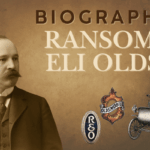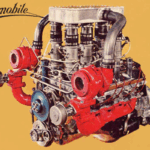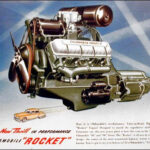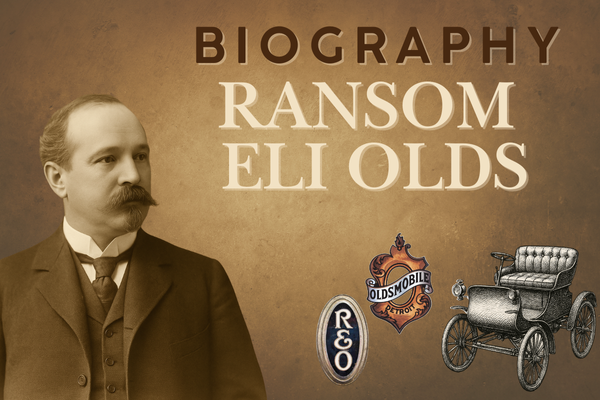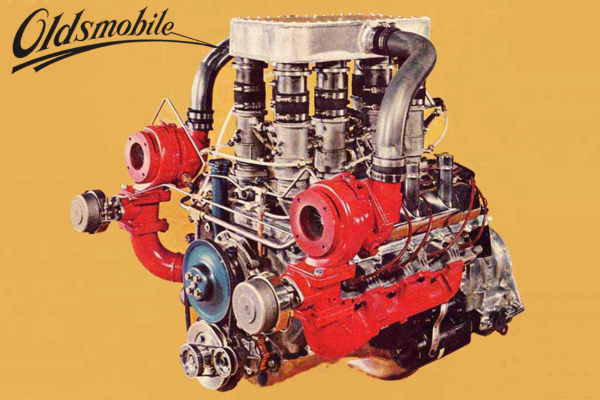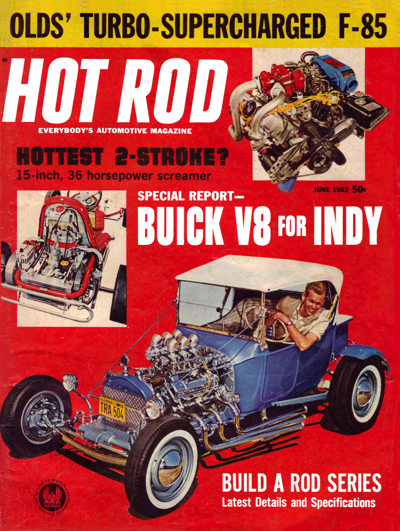Early 1900s Automotive History innovations and other notable achievements:
The early 1900s had a significant impact on the American automobile industry, and there were several key innovations that shaped the future of the industry, culture, and our society.

A 1905 Spyker 12-16HP Doube Phaeton was featured in the film Genevieve alongside the 1904 Darracq. Image from the National Automobile Museum.
- The assembly line: Henry Ford introduced the concept of the assembly line to automobile manufacturing in 1913. This allowed for the mass production of cars, making them more affordable for the average person.
- The electric starter: In 1911, Charles Kettering invented the electric starter, which replaced the cumbersome hand crank and made it much easier to start the car.
- The first commercial car radio: The first car radio was developed in 1929 by Paul and Joseph Galvin, who later founded the Motorola Corporation.
- The Model T: The Model T was introduced in 1908 by Henry Ford and became the first car to be mass-produced on an assembly line. It was also the first car to be affordable for the average person.
- The first car with a V8 engine: Cadillac introduced the first car with a V8 engine in 1914. This engine design became popular in the years that followed and is still used today.
- The first cross-country road trip: In 1903, H. Nelson Jackson and Sewall K. Crocker became the first people to drive across the United States in a car, a Winton touring car.
- The first car with four-wheel brakes: The 1914 Duesenberg Model A became the first car to have four-wheel brakes, which greatly improved safety and stopping power.
Defunct Brands from Early 1900s Automotive History
The below brands were important and influential in early 1900s automotive history that helped to shape the direction of the automotive industry. Its innovative designs, racing success, and legacy of innovation continue to be remembered and appreciated today

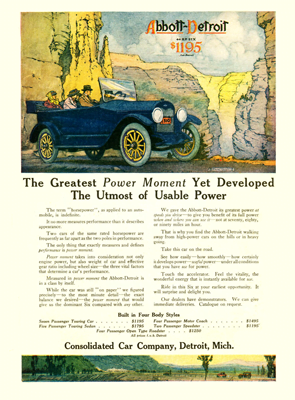
The Abbott-Detroit Automobile Company was an American automobile manufacturer that operated from 1909 to 1916. Here are some of the highlights of the company:
-
Innovative designs: The Abbott-Detroit company was known for producing cars with unique designs that were different from the typical designs of other automobile manufacturers of the time.
-
Racing success: The company’s cars were successful in racing competitions, which helped to promote the brand and attract customers.
-
Quality craftsmanship: The cars produced by Abbott-Detroit were known for their high-quality craftsmanship and attention to detail.
-
Popular models: Some of the most popular models produced by the company included the Abbott-Detroit “40”, the “44”, and the “6-44”.
-
Limited production: Abbott-Detroit was a relatively small company, and it produced a limited number of cars compared to some of its larger competitors.
-
Financial struggles: Despite the company’s success in terms of design and racing, it struggled financially due to a lack of investment and a limited market share.
-
Acquisition: In 1916, the Abbott-Detroit company was acquired by the Hudson Motor Car Company, which continued to produce cars under the Abbott-Detroit brand for a few more years before phasing out the brand altogether.


Adams-Farwell-1898 – 1912
The Adams-Farwell Company was an American automobile manufacturer that operated from 1896 to 1913. The company was known for its innovative designs and advanced technology, and it produced a number of notable vehicles during its existence. Some of the highlights of the Adams-Farwell automotive company include:
- The Adams-Farwell three-wheeler: The company’s first vehicle was a three-wheeled car that was powered by a single-cylinder engine. The car was notable for its unique design, which included a front-mounted engine and a chain drive to the rear wheel.
- The Adams-Farwell 6A: This car was introduced in 1905 and was powered by a six-cylinder engine. It was notable for its advanced technology, including a flywheel that doubled as a brake and an air-cooled engine that did not require a radiator.
- The Adams-Farwell Model 8: This car was introduced in 1910 and was powered by an eight-cylinder engine. It was the first American car to feature an aluminum body and was also notable for its advanced suspension system.
- The Adams-Farwell Aerocar: This was a prototype flying car that was developed in the early 1900s. The car was designed to be able to convert into an airplane by attaching wings and a propeller. While the Aerocar was never put into production, it was a groundbreaking concept that foreshadowed the development of modern flying cars.
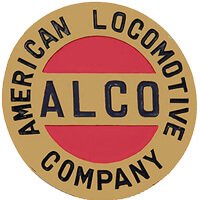

Alco – 1906 – 1913
The American Locomotive Company (ALCO) was primarily known for its production of steam locomotives in the late 19th and early 20th centuries. However, the company also manufactured automobiles for a brief period of time from 1905 to 1913. Here are some highlights of the American Locomotive Automobile Company:
-
ALCO’s first automobile was a high-end luxury car called the “ALCO Black Beast,” which was introduced in 1905.
-
In 1909, ALCO started production of a more affordable car called the “ALCO Six,” which was powered by a six-cylinder engine.
-
The ALCO Six was known for its advanced engineering, including a steel frame and hydraulic shock absorbers.
-
ALCO’s automobiles were marketed as being among the most powerful and reliable on the market.
-
Despite the quality of its cars, ALCO struggled to compete with larger automobile manufacturers like Ford and General Motors, and ceased production of automobiles in 1913.
-
Today, ALCO’s automobiles are rare and highly sought after by collectors. The company’s legacy lives on through its contribution to the development of steam locomotives, which played a critical role in the growth and expansion of the American economy in the early 20th century.


American Underslung – 1905 – 1914
The American Underslung Automobile Company was a relatively short-lived automobile manufacturer, active from 1905 to 1914, but it made several important contributions to the history of the automobile. Here are some of the highlights of the company:
- Innovative underslung chassis design: The American Underslung was one of the first cars to use an underslung chassis design, which positioned the car’s main frame below the axles rather than above them. This allowed the car to sit lower to the ground, giving it a sporty and streamlined appearance. The underslung design also improved handling and stability by lowering the car’s center of gravity.
- Stylish and powerful cars: The American Underslung was known for its high-performance cars, with many models featuring powerful four- and six-cylinder engines. The cars were also stylishly designed, with sleek lines and attention to detail that made them stand out from other automobiles of the time.
- Racing success: The American Underslung had a successful racing career, winning several races and setting speed records. The company’s racing success helped to establish its reputation as an innovative and high-performance automaker.
- Limited production: The American Underslung was a small-scale manufacturer that produced only a few thousand cars during its existence. This limited production, combined with the company’s innovative design and racing success, has made the Underslung a highly sought-after collector’s item today.


Borland Electric – 1910 – 1916
Borland Electric Automobiles was an electric vehicle manufacturer that was active in the early 20th century. Here are some of the highlights of the company:
-
Early electric vehicle manufacturer: Borland Electric Automobiles was one of the earliest electric vehicle manufacturers, producing electric cars as early as 1902. At the time, electric cars were seen as a promising alternative to gasoline-powered vehicles, and Borland was one of the pioneers in this field.
-
Innovative electric vehicle design: Borland’s electric vehicles were known for their innovative design, with features like regenerative braking and a unique gearbox that allowed for smooth and efficient acceleration. The cars also had a sleek and modern design that set them apart from other electric vehicles of the time.
-
Limited production: Like many early automobile manufacturers, Borland Electric Automobiles had a limited production run. The company produced only a few hundred electric cars before going out of business in 1911. Today, these cars are highly sought-after by collectors and enthusiasts.
-
Legacy of innovation: Despite its relatively short existence, Borland Electric Automobiles left a lasting legacy of innovation in the field of electric vehicles. The company’s designs and technologies helped to pave the way for modern electric cars, which continue to gain in popularity and importance in the 21st century.
Overall, Borland Electric Automobiles was an important player in the early history of electric vehicles, and its innovative designs and technologies continue to inspire and influence the development of electric cars today.


Elmore – 1893 – 1912
The Elmore Automobile Company was a pioneering American automobile manufacturer that operated from 1893 to 1912. Here are some of the highlights of the company:
- Early automobile manufacturer: The Elmore Automobile Company was one of the earliest automobile manufacturers in the United States. It was founded in 1893, just a few years after the first automobiles were invented.
- Innovative designs: Elmore was known for its innovative designs, which included features like chainless drive and front-wheel drive. The company’s vehicles were also well-engineered and well-constructed, which helped to establish its reputation for quality and reliability.
- Racing success: Elmore automobiles were successful in racing competitions, winning numerous events and setting several speed records. This helped to boost the company’s reputation and raise its profile in the automotive industry.
- Limited production: Elmore was a relatively small-scale manufacturer, producing only a few thousand vehicles during its existence. This limited production has made Elmore automobiles rare and highly sought-after by collectors and enthusiasts.


Inter-State – 1909 – 1919
Inter-State Automobiles was an American automobile manufacturer that operated from 1909 to 1915. Here are some of the highlights of the company:
- Innovative designs: Inter-State was known for its innovative designs, which included features like a V-shaped radiator, a double-drop frame, and a multi-speed transmission. These features helped to set the company’s automobiles apart from others in their class and contributed to their popularity.
- Quality craftsmanship: Inter-State automobiles were known for their high-quality construction and attention to detail. The company used only the best materials and employed skilled craftsmen to build its vehicles, which helped to establish its reputation for quality and reliability.
- Racing success: Inter-State automobiles were successful in racing competitions, winning several events and setting speed records. This helped to raise the company’s profile and reputation in the automotive industry.
- Limited production: Inter-State was a relatively small-scale manufacturer, producing only a few thousand vehicles during its existence. This limited production has made Inter-State automobiles rare and highly sought-after by collectors and enthusiasts.


Klink – 1907 – 1910
Klink Automobiles was an American automobile manufacturer that operated from 1900 to 1912. Here are some of the highlights of the company:
- Early automobile manufacturer: Klink was one of the early automobile manufacturers in the United States, producing vehicles as early as 1900. At the time, automobiles were still a relatively new and emerging technology, and Klink was at the forefront of this exciting new industry.
- Innovative designs: Klink was known for its innovative designs, which included features like a unique double-chain drive and a flexible steering system. The company’s vehicles were also well-engineered and well-constructed, which helped to establish its reputation for quality and reliability.
- Racing success: Klink automobiles were successful in racing competitions, winning numerous events and setting several speed records. This helped to boost the company’s reputation and raise its profile in the automotive industry.
- Limited production: Klink was a relatively small-scale manufacturer, producing only a few hundred vehicles during its existence. This limited production has made Klink automobiles rare and highly sought-after by collectors and enthusiasts.


K-R-I-T 1909 – 1916
K-R-I-T (pronounced “Krit”) was an American automobile manufacturer that operated from 1909 to 1916. Here are some of the special features of the K-R-I-T automobiles:
- Innovative designs: K-R-I-T was known for its innovative designs, which included features like a “motor-in-front” layout, an all-steel frame, and a double-drop frame. These features helped to set the company’s automobiles apart from others in their class and contributed to their popularity.
- High-quality craftsmanship: K-R-I-T automobiles were known for their high-quality construction and attention to detail. The company used only the best materials and employed skilled craftsmen to build its vehicles, which helped to establish its reputation for quality and reliability.
- Affordable pricing: K-R-I-T automobiles were priced to be affordable for the average consumer, making them a popular choice for people looking for a reliable and stylish car at a reasonable price.
- Racing success: K-R-I-T automobiles were successful in racing competitions, winning several events and setting speed records. This helped to raise the company’s profile and reputation in the automotive industry.


Lozier 1900 – 1918
Lozier was an American luxury automobile manufacturer that operated from 1900 to 1918. Here are some of the special features of Lozier automobiles:
-
High-quality craftsmanship: Lozier automobiles were known for their exceptional quality and attention to detail. The company used only the best materials and employed skilled craftsmen to build its vehicles, which helped to establish its reputation for luxury and reliability.
-
Powerful engines: Lozier automobiles were equipped with powerful engines that were among the most advanced of their time. The company’s engines were known for their smooth and quiet operation, as well as their impressive performance.
-
Innovations in design: Lozier was at the forefront of automotive design, and the company’s vehicles were known for their innovative features and elegant styling. For example, Lozier was one of the first companies to introduce a steering wheel instead of a tiller for steering, and the company’s cars featured a unique “floating power” system that helped to reduce engine vibration.
-
Racing success: Lozier automobiles were successful in racing competitions, winning several events and setting speed records. This helped to raise the company’s profile and reputation in the automotive industry.
-
Limited production: Lozier was a relatively small-scale manufacturer, producing only a few thousand vehicles during its existence. This limited production has made Lozier automobiles rare and highly sought-after by collectors and enthusiasts


- Innovative designs: Matheson was known for its innovative designs, which included features like a unique “underslung” chassis and a powerful 50-horsepower engine. These features helped to set the company’s automobiles apart from others in their class and contributed to their popularity.
- Racing success: Matheson automobiles were successful in racing competitions, winning numerous events and setting several speed records. This helped to boost the company’s reputation and raise its profile in the automotive industry.
- High-quality construction: Matheson automobiles were known for their high-quality construction and attention to detail. The company used only the best materials and employed skilled craftsmen to build its vehicles, which helped to establish its reputation for quality and reliability.
- Limited production: Matheson was a relatively small-scale manufacturer, producing only a few hundred vehicles during its existence. This limited production has made Matheson automobiles rare and highly sought-after by collectors and enthusiasts.


Northern was an American automobile brand that was produced by the Northern Manufacturing Company from 1902 to 1905. While the company was only in business for a short time, they made a significant impact on the automotive industry through their innovative designs and advanced technologies.
One of the key features of Northern automobiles was their lightweight construction. The company used a combination of aluminum, magnesium, and other lightweight materials in their cars, which helped to improve their speed and handling. Northern also used a unique shaft drive system, which was more efficient and reliable than the chain drive systems used by many of their competitors.
Northern was also one of the first companies to use a steering wheel instead of the tiller-style steering that was common at the time. They also used a number of other advanced technologies in their cars, including a four-speed transmission and a high-performance engine that was capable of reaching speeds of up to 60 miles per hour.
In addition to their technical innovations, Northern also focused on providing a high level of comfort and luxury for their customers. They used high-quality materials and finishes in their cars, and they offered a variety of customization options to meet the individual needs and preferences of their customers.


Pope Toledo 1903 – 1909
The Pope-Toledo was an American automobile brand that was produced by the Toledo, Ohio-based Pope Motor Car Company from 1903 to 1909. During this time, the company made several notable innovations that helped to advance the technology and design of automobiles.
One of the key innovations of the Pope-Toledo was their use of an overhead camshaft engine. This was a relatively new technology at the time, and it allowed the engine to operate more efficiently and generate more power. Pope-Toledo also used a number of other advanced technologies in their cars, including four-wheel brakes and a four-speed transmission.
Another notable innovation of the Pope-Toledo was their use of high-quality materials and finishes in their cars. The company was known for its attention to detail and craftsmanship, and its cars were considered some of the most luxurious and well-made vehicles of their time.
Pope-Toledo was also one of the first companies to use standardized, interchangeable parts in their cars. This made it easier and more cost-effective to repair and maintain the vehicles, and it helped to pave the way for modern automotive manufacturing practices.


Rambler 1900 -1914
The Rambler was an American automobile brand that was produced by the Thomas B. Jeffery Company from 1900 to 1914. The company was known for its innovative designs and technologies, which helped to establish it as a leading automotive manufacturer during the early 20th century.
One of the key innovations of the early Rambler automobiles was their use of a lightweight, streamlined design. The company used a combination of steel, aluminum, and other lightweight materials in their cars, which helped to improve their speed and handling. They also used a unique tubular frame construction that was both strong and lightweight.
Another notable innovation of the early Rambler automobiles was their use of a center-pivot steering system. This system allowed the driver to steer the car with greater precision and control, and it helped to improve the handling of the vehicle.
Rambler was also one of the first companies to use a sliding-gear transmission in their cars. This technology allowed for smoother shifting and better performance, and it helped to pave the way for modern manual transmissions.
In addition to these technical innovations, Rambler also focused on providing a high level of comfort and convenience for their customers. They offered a variety of customization options, such as different body styles and paint colors, and they were known for their attention to detail and quality craftsmanship.


Ralph Beardsley and J.D. Coote in a Simplex 90hp at the 1910 Vanderbilt Cup Race where they placed 7th
Simplex 1907 – 1919
Simplex was an American luxury automobile brand that was produced by the Simplex Automobile Company from 1907 to 1922. The company was known for its high-quality craftsmanship and innovative designs, which helped to establish it as one of the leading luxury car manufacturers of its time.
One of the key features of Simplex automobiles was their powerful and advanced engines. The company used a variety of different engines in their cars, including inline-six and inline-eight engines, that were capable of producing high levels of horsepower and torque. They also used advanced technologies in their engines, such as overhead camshafts and four-valve cylinder heads, that helped to improve performance and fuel efficiency.
Simplex was also known for their innovative suspension systems. They used a unique system of semi-elliptical leaf springs and hydraulic shock absorbers, which provided a smooth and comfortable ride even on rough roads.
In addition to their technical innovations, Simplex also focused on providing a high level of luxury and comfort for their customers. They used high-quality materials and finishes in their cars, such as fine leather upholstery and polished wood accents, and they offered a variety of customization options to meet the individual needs and preferences of their customers.
A highly innovative and forward-thinking automobile brand that helped to push the boundaries of automotive design and technology during the early 20th century. Their cars were considered some of the most luxurious and advanced vehicles of their time.


Speedwell 1907 – 1917
While the company was only in business for a few years, it made a name for itself by producing high-quality, luxury vehicles that were highly advanced for their time.
One of the most unique features of Speedwell automobiles was their innovative V8 engine. This engine was one of the first V8 engines ever produced for use in an automobile, and it was more powerful and efficient than many of the engines used by their competitors.
Speedwell also used a number of other advanced technologies in their automobiles. For example, they were one of the first companies to use four-wheel brakes, which helped to improve the safety and handling of their cars. They also used high-quality materials and finishes in their cars, which helped to give them a luxurious feel.
In addition to its technical innovations, Speedwell also focused on providing a high level of customer service. They offered a variety of customization options for their cars, and they were known for their attention to detail and quality craftsmanship.
Overall, Speedwell Automobiles was a highly innovative and forward-thinking company that helped to advance the technology and design of automobiles during the early 20th century.


Waverley 1909 – 1916
Waverley Automobiles was an American electric car manufacturer that operated from 1898 to 1916. The company was known for its early innovations in electric car technology.
One of Waverley’s key innovations was the use of lead-acid batteries to power their electric vehicles. The company also developed a charging system that allowed drivers to recharge their cars using a standard electrical outlet.
Waverley also made advances in the design of electric motors. The company’s motors were more efficient and powerful than those used by many of their competitors, which helped to make their electric cars more competitive with gasoline-powered vehicles.
In addition to these technical innovations, Waverley also focused on making their electric cars more user-friendly. For example, they developed a steering wheel instead of the tiller-style steering used by many early electric cars, which made the cars easier to drive.
Overall, Waverley Automobiles played an important role in the early development of electric car technology and helped to pave the way for future electric car manufacturers.


White 1900 – 1918
Quality construction: White automobiles were known for their high-quality construction and attention to detail. The company used only the best materials and employed skilled craftsmen to build its vehicles, which helped to establish its reputation for quality and reliability.
- Powerful engines: White automobiles were powered by large and powerful engines that were capable of delivering impressive performance for the time. The engines were often designed for heavy-duty use in commercial applications, which gave them a reputation for durability and reliability.
- Dependable transmissions: White automobiles were equipped with dependable and smooth-shifting transmissions, which were well-suited for both commercial and personal use. The company’s transmissions were known for their durability and ease of operation.
- Innovations in design: White was known for its innovative designs, which included features like a four-wheel braking system, a semi-automatic transmission, and a powerful six-cylinder engine. These features helped to set the company’s automobiles apart from others in their class and contributed to their popularity.


Woods 1899 – 1916
Here are some of the special features of Woods Motor Cars:
- Innovations in design: Woods was known for its innovative designs, which included features like an all-steel body, an enclosed cabin, and a unique hybrid gasoline-electric powertrain. The hybrid powertrain was one of the first of its kind and allowed for both gasoline and electric power to be used for propulsion, depending on driving conditions.
- Quiet and smooth operation: The hybrid powertrain made Woods Motor Cars exceptionally quiet and smooth to drive, which was a major selling point for the company. The electric motor provided smooth and instant torque, while the gasoline engine could be used for longer-range driving.
- High-quality craftsmanship: Woods automobiles were known for their high-quality construction and attention to detail. The company used only the best materials and employed skilled craftsmen to build its vehicles, which helped to establish its reputation for quality and reliability.
- Popular with celebrities: Woods Motor Cars were a popular choice among celebrities and wealthy individuals, who appreciated the company’s innovative designs and luxurious features.



